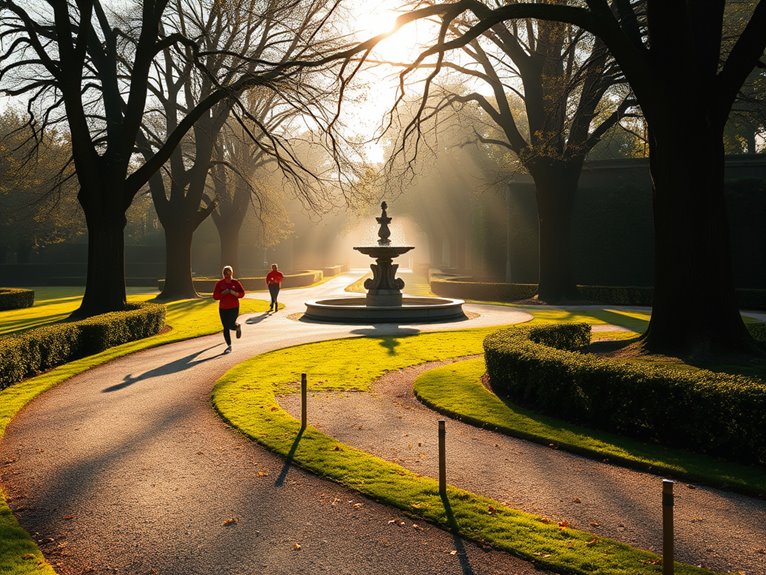
6 Scenic Jogging Routes Through Paris Parks
I'll show you six breathtaking jogging routes through Paris's most iconic parks! Start with the historic 1.2km Tuileries Loop, then explore Luxembourg Gardens' 2.5km circuit. For a wilder adventure, try Bois de Boulogne's extensive trails or jog along Canal Saint-Martin's urban charm. Don't miss Parc des Buttes-Chaumont's scenic paths, and cap it off at Bois de Vincennes' 9.4km track. Each route offers unique features, from manicured gardens to hidden lakes – there's so much more to discover!
Training Through History: Jardin Des Tuileries Loop
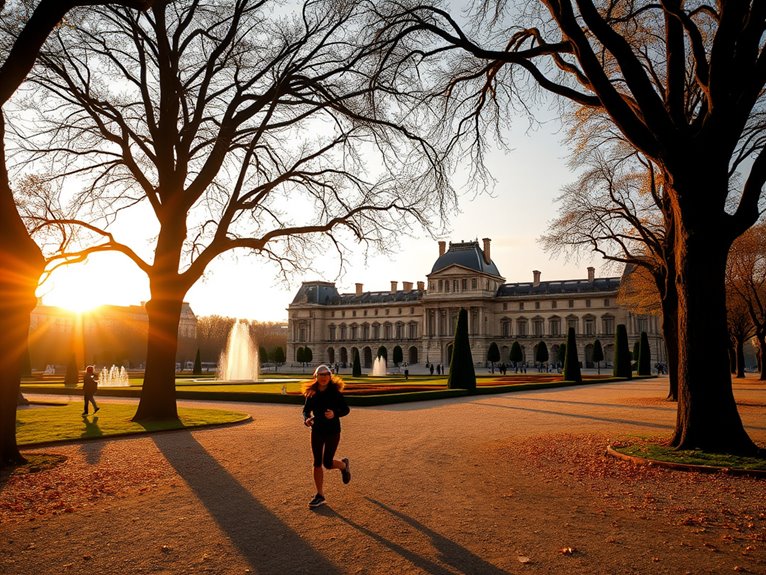
Running through the Jardin des Tuileries offers joggers a unique blend of physical exercise and cultural immersion, as each stride takes them past centuries of French history. This former royal garden, stretching from the Louvre to Place de la Concorde, provides runners with a flawlessly manicured 1.2-kilometer loop that combines both gravel paths and paved surfaces.
The Tuileries loop stands out among Parisian running routes for its flat terrain and strategic location in the heart of the city. Runners can admire perfectly aligned trees, historic fountains, and world-class sculptures while maintaining their training rhythm, making it an excellent choice for both serious athletes and casual joggers seeking a memorable workout experience.
Quick Facts:
- Best running times: 6:00-9:00 AM or after 7:00 PM
- Distance: 1.2 km per loop
- Surface type: Mixed (gravel and paved)
- Water fountains: Available April-October
- Garden hours: 7:00 AM to 9:00 PM (summer), 7:00 AM to 7:30 PM (winter)
- Security presence: 24/7
- Restroom availability: Multiple locations during garden hours
The Main Loop
The classic Tuileries running route follows the garden's perimeter, starting at the Louvre entrance and proceeding clockwise. This path offers prime distance markers and minimal tourist interference during early morning hours. The route passes several notable landmarks, including the Orangerie Museum and the iconic octagonal basin, where runners can pause for stretching or recovery. Insider tip: The northwestern corner near Place de la Concorde offers a lesser-known drinking fountain that's operational year-round.
Pro Tips:
Early morning runners should enter through the Place de la Concorde gate, as it opens slightly earlier than other entrances. The garden's symmetrical design creates natural interval training opportunities – use the distance between fountains (approximately 200 meters) as sprint segments. For an extended workout, incorporate the adjacent Rue de Rivoli sidewalk or connect to the Seine River promenade.
Practical Considerations:
Pack light and wear reflective gear if running during darker hours. The gravel sections can be slightly loose after rain, so adjust your pace accordingly. Consider joining local running groups that meet at the Tuileries on weekend mornings – they often share alternative routes and seasonal tips while providing a social aspect to your training routine.
The Royal Run: Luxembourg Gardens Circuit
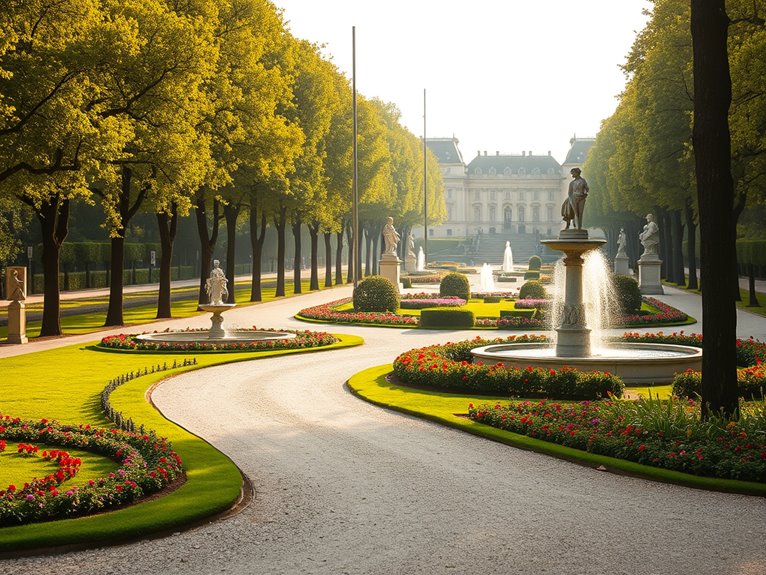
The Luxembourg Gardens Circuit stands as one of Paris's most prestigious running routes, combining French Renaissance splendor with athletic pursuit. This 2.5-kilometer loop around and through the historic Luxembourg Gardens offers runners a uniquely Parisian experience, where manicured flowerbeds, iconic fountains, and centuries-old statues create an aristocratic backdrop for your workout.
Following in the footsteps of French royalty, this running circuit delivers both historical significance and practical training benefits. The perfectly maintained gravel paths, multiple elevation changes, and strategic distance markers make it ideal for interval training, while the gardens' central location in the 6th arrondissement provides easy access from multiple Metro stations.
Quick Facts:
- Operating Hours: 7:30 AM to sunset (varies seasonally)
- Best Running Times: Early morning (7:30-9:00 AM) or late afternoon (4:00-6:00 PM)
- Surface Type: Crushed gravel paths
- Distance: 2.5 km per loop
- Difficulty Level: Moderate
- Water Fountains: Available April-October
- Restroom Facilities: Yes (small fee required)
- Security: Regular park guard presence
The Luxembourg Gardens Circuit follows a well-defined path that begins at the northern entrance near the iconic Medici Fountain. The route takes runners past the grand Luxembourg Palace, currently home to the French Senate, and continues through various themed gardens including the English Garden, the Orangerie, and the famous central pond where children sail toy boats. The path is clearly marked with distance indicators, making it easy to track your progress.
Pro Tips:
Early morning runners gain exclusive access to near-empty pathways and perfect photo opportunities before the tourist crowds arrive. Consider running counterclockwise to maximize shade coverage during warmer months, and take advantage of the slight incline on the eastern side for additional training benefits. The garden's multiple entry points allow runners to easily modify their route length by cutting through various sections.
Practical Advice:
Bring cash for restroom facilities and consider wearing trail running shoes during wet weather as the gravel paths can become slightly loose. Respect the garden's rules by staying on designated running paths and avoiding grass areas. During peak tourist seasons (June-August), plan your run for early morning or consider alternative times to avoid crowds. The garden closes at sunset, with guards making announcements 30 minutes prior to closure, so time your run accordingly.
Hidden Trails of Bois De Boulogne
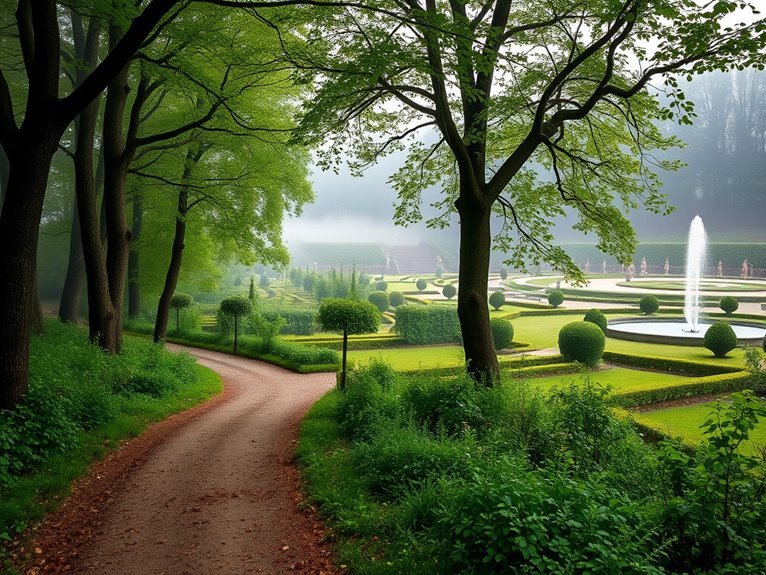
Nestled on the western edge of Paris, the Bois de Boulogne's hidden trails offer joggers an enchanting escape from the city's bustling streets. This former royal hunting ground, spanning 2,090 acres, has transformed into a verdant paradise where ancient pathways weave through dense woodlands, serene lakes, and botanical gardens.
Beyond the well-known main paths, a network of lesser-explored trails beckons adventurous runners to discover the park's hidden treasures. These secret routes provide intimate encounters with local wildlife, stunning seasonal flora, and peaceful corners that feel worlds away from urban Paris, while offering varying degrees of difficulty to suit different fitness levels.
Quick Facts:
- Best running times: Dawn to 10 AM or 4 PM to sunset
- Trail difficulty: Easy to moderate
- Required gear: Running shoes with good grip, water bottle, mobile phone
- Seasonal considerations: Muddy in winter, shaded in summer
- Safety: Run with a partner during early morning/evening hours
- Distance options: 2km to 15km loops available
The Lake Trail (Circuit des Lacs)
This 5km trail circles the park's two main lakes, Lac Inférieur and Lac Supérieur. The packed gravel path provides excellent running conditions while offering stunning water views and wildlife spotting opportunities. Access points are available from Porte Dauphine or Porte de Passy metro stations. Insider tip: The small islands in Lac Inférieur host rare bird species – pause near the southeastern shore at sunrise for the best wildlife viewing.
The Waterfall Path (Sentier des Cascades)
A challenging 3km trail featuring elevation changes and natural obstacles, this hidden gem winds past the park's artificial waterfalls. Located in the northwestern section, access via Porte de Suresnes. The route includes wooden bridges and stone steps, perfect for interval training. Insider tip: A secret viewing platform near the second waterfall offers panoramic views of La Défense district.
The Pre-Saint-James Loop
This secluded 4km trail skirts the edges of the Pre-Saint-James gardens, offering a mix of wooded areas and manicured landscapes. Enter from Porte de Madrid for the best starting point. The trail features softer terrain, ideal for reducing impact on joints. Insider tip: An unmarked path behind the Shakespeare Garden leads to a centuries-old oak tree, perfect for mid-run stretching.
Pro Tips:
Early morning runners should focus on the eastern trails, where sunrise creates magical light effects through the trees. Weekday mornings offer the most solitary experience, while weekend afternoons see more foot traffic. During summer months, the Pre-Saint-James Loop provides the most shade coverage, making it ideal for afternoon runs. Consider alternating between trails to discover seasonal changes and wildlife patterns.
Practical Advice:
Download an offline map before your first visit, as cellular coverage can be spotty in some areas. Carry a small water bottle and energy snack, as water fountains are sparse on hidden trails. While the park is generally safe, stick to more populated trails if running alone, and always inform someone of your planned route. The best access points for hidden trails are from Porte Dauphine and Porte de Suresnes, where free parking is available before 9 AM.
Riverside Exercise: Canal Saint-Martin Path
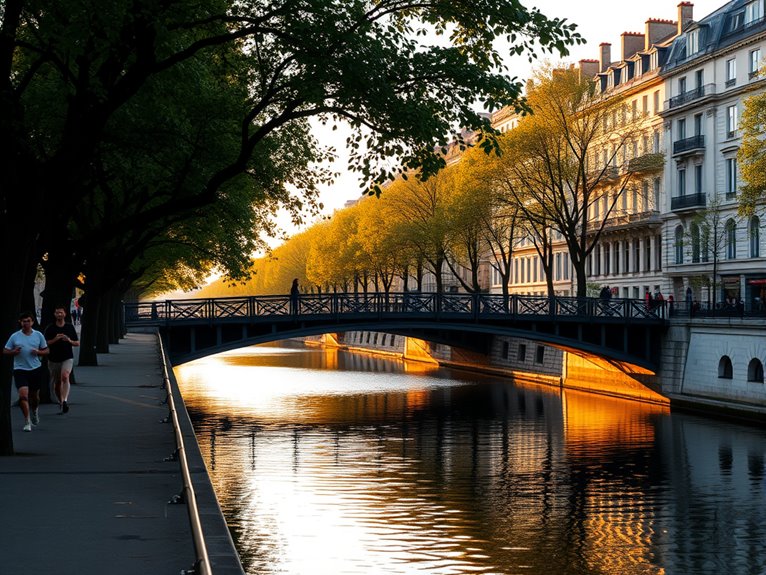
The Canal Saint-Martin path offers runners a revitalizing alternative to Paris's more touristy running routes, threading through one of the city's most vibrant and authentic neighborhoods. This 4.5-kilometer waterway, lined with iron footbridges and century-old trees, provides a unique blend of urban charm and peaceful waterfront running that has become increasingly popular among local fitness enthusiasts and visitors alike.
Running along this historic canal, built under Napoleon Bonaparte in 1802, combines cultural immersion with physical activity. The path takes joggers past trendy cafes, artisanal shops, and street art while maintaining a consistent, flat terrain that's ideal for runners of all levels. The route's industrial heritage, transformed into a bohemian paradise, creates an atmosphere that's distinctly Parisian yet revitalizing off the beaten path.
Quick Facts:
- Best running times: 6:00-8:00 AM or 7:00-9:00 PM
- Distance: 4.5 kilometers one-way
- Surface type: Mixed (concrete and cobblestone)
- Water fountains: Available every 800 meters
- Lighting: Well-lit until 11 PM
- Difficulty level: Easy to moderate
- Bathroom facilities: Available at Jardin Villemin and Place de la République
Path Details:
The route begins at Place de la Bastille, where the canal emerges from underground, and continues north to La Villette. The first section features charming locks and iconic iron bridges, perfect for interval training as runners can use these landmarks as natural distance markers. The path is wide enough to accommodate both runners and pedestrians, with dedicated areas marked for different users.
Pro Tips:
Early morning runs offer the most serene experience, as the neighborhood comes to life with local vendors setting up their shops and cafes preparing for the day. Weekend afternoons tend to get crowded with picnickers and tourists, especially during summer months. Consider running the route in segments, using the various bridges as turning points, to create custom-length workouts.
Practical Advice:
Wear shoes with good grip, as some sections of the path can be slippery when wet. Carry a small water bottle despite the presence of fountains, as some may be under maintenance. The path connects with several other running routes, including Parc de la Villette and Bassin de la Villette, allowing runners to extend their workout as desired. Many cafes along the route welcome runners for post-workout revitalizations, but it's advisable to carry a light jacket or running cover-up for these stops.
Green Heart of Paris: Parc Des Buttes-Chaumont Route
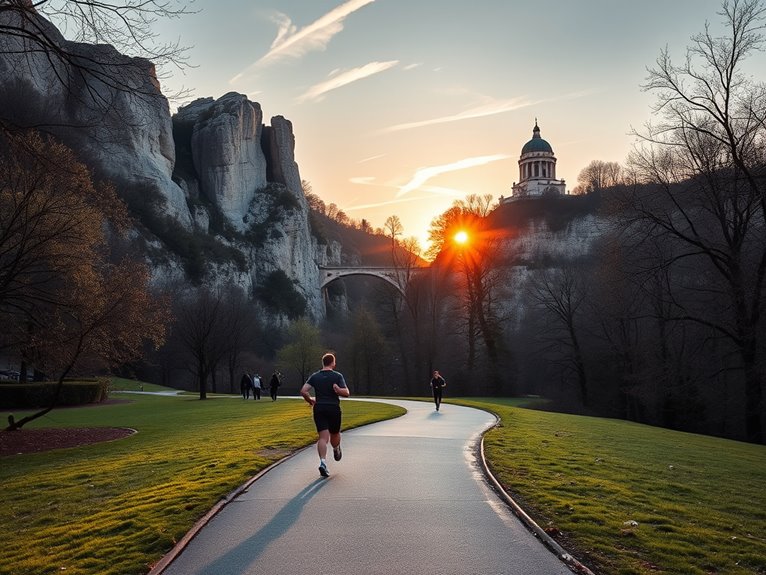
The Parc des Buttes-Chaumont stands as one of Paris's most dramatic and architecturally striking green spaces, offering joggers an exceptional urban running experience. This 19th-century park, carved from an abandoned quarry, presents runners with challenging elevations, winding paths, and spectacular viewpoints that make every workout memorable.
Unlike the flat terrain of central Paris, this 61-acre park provides varied elevation changes that naturally enhance workout intensity while rewarding runners with panoramic views of Montmartre and the Sacré-Cœur. The route encompasses artificial lakes, waterfalls, and the iconic Temple de la Sibylle perched atop a 50-meter cliff, creating a uniquely Parisian training environment that blends natural beauty with historical significance.
Quick Facts:
- Best running times: 7:00-9:00 AM or 6:00-8:00 PM
- Distance: 2.5 km main loop (multiple path options)
- Elevation gain: 100+ meters
- Water fountains: 6 locations throughout
- Restroom facilities: 3 locations
- Surface type: Mixed (paved and gravel)
- Lighting: Well-lit until park closing
- Park hours: 7:00 AM to 8:00 PM (varies seasonally)
Main Running Circuit:
The signature running route follows the park's outer circuit, starting at the main entrance on Rue Botzaris. This 2.5-kilometer loop incorporates the park's most striking features while providing consistent elevation changes. The path winds past the lake, crosses the suspended bridge (Pont des Suicides), and circles the central peak, offering multiple options to extend or shorten the workout through connecting paths.
Pro Tips:
Morning runners should tackle the elevation clockwise to catch the sunrise over Paris from the Temple viewpoint. The park's multiple entrances allow for creative route planning, but the Botzaris entrance offers the gentlest warm-up incline. Consider incorporating the stone stairways for high-intensity interval training, particularly the steps leading to the Temple de la Sibylle.
Practical Considerations:
The park's terrain can be slippery after rain, particularly on the steeper sections and stone steps. Wearing trail running shoes is recommended, especially during wet seasons. The park becomes crowded on weekends after 10:00 AM, so early morning runs are ideal for uninterrupted training. Several water fountains along the route provide reliable hydration points, but runners should carry their own water during peak summer months when fountains may be heavily used.
Urban Wilderness: Bois De Vincennes Track
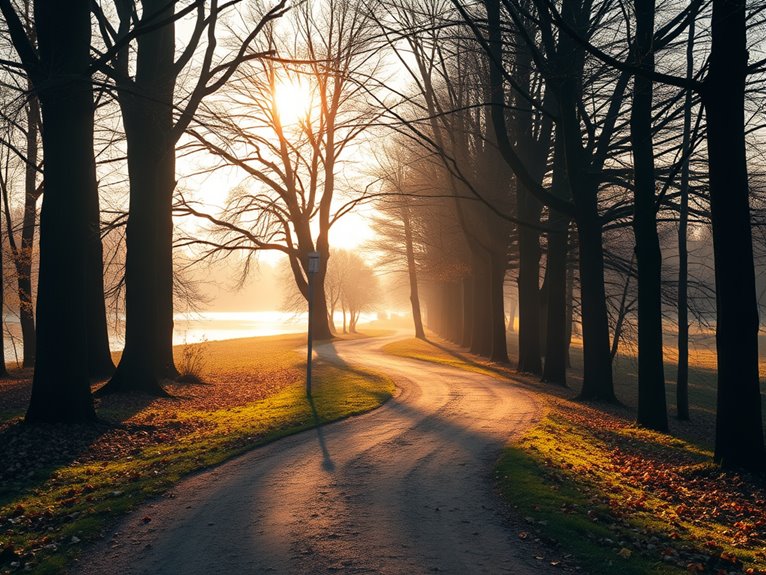
The Bois de Vincennes track offers Paris's most extensive green running sanctuary, spanning nearly 2,500 acres of pristine parkland on the city's eastern edge. This former royal hunting ground has transformed into a runner's paradise, featuring a network of well-maintained paths that wind through dense woodlands, around crystalline lakes, and past historic landmarks like the medieval Château de Vincennes.
This urban wilderness provides an extraordinary escape from Paris's bustling streets, offering runners a unique blend of natural beauty and architectural heritage. The main running track extends 9.4 kilometers around the park's perimeter, while numerous interconnected paths allow joggers to customize their routes according to preferred distance and difficulty levels, making it suitable for both casual joggers and serious athletes.
Quick Facts:
- Best running hours: 6:00 AM – 10:00 PM (optimal: dawn or dusk)
- Distance options: 3km to 15km loops available
- Surface types: Mixed (packed earth, asphalt, woodland trails)
- Elevation: Mostly flat with gentle inclines
- Facilities: Water fountains, restrooms, changing rooms
- Access: Multiple Metro stations (Line 1, Exit Château de Vincennes)
- Safety level: High, well-lit main paths
- Season recommendations: Year-round, spectacular in autumn
Main Track Features:
The signature perimeter track offers a well-marked path with distance markers every kilometer, specialized running surfaces, and dedicated lanes for different speeds. The route passes four lakes, the tropical garden greenhouse, and several historical monuments. Drinking fountains are strategically placed every 2 kilometers, and emergency call points are available throughout the course.
Location:
Route de la Pyramide, 75012 Paris
Main entrance coordinates: 48.8302° N, 2.4113° E
Insider tip: The lesser-known eastern entrance near the Lac des Minimes offers immediate access to the quietest section of the track and features a hidden warming hut perfect for winter running preparation.
Pro Tips:
Early morning runners should target the track section near the Lac Daumesnil, where the rising sun creates stunning reflections on the water's surface. For those seeking isolation, the southeastern woodland trails between 2:00 PM and 4:00 PM are especially quiet. Serious runners can incorporate the park's natural elevation changes near the Redoute de Gravelle for interval training.
Practical Considerations:
Pack a small running backpack with water during summer months, despite available fountains. The park's size means cellular coverage can be spotty in some areas, so download offline maps beforehand. While the main paths are well-lit, reflective gear is recommended for dawn or dusk runs. Several bike-sharing stations around the park's perimeter allow for combined cardio workouts, and the nearby Château de Vincennes metro station offers convenient locker facilities for belongings.
